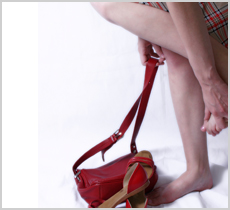Bunions Triggers Signs Or Symptoms And Treatment Methods
Overview
 A bunion, also known as hallux valgus, results when the big toe points towards the second toe and results in inflammation of the tissue surrounding the joint. The inflammation causes the joint to become swollen and tender, making everyday activities like walking or jogging very painful. Bunions are much more common in females than in men. This leads most to believe that bunions are often time caused by wearing tight fitting shoes or heels. Genetics also plays an important role in determining the individual?s susceptibility to developing the condition.
A bunion, also known as hallux valgus, results when the big toe points towards the second toe and results in inflammation of the tissue surrounding the joint. The inflammation causes the joint to become swollen and tender, making everyday activities like walking or jogging very painful. Bunions are much more common in females than in men. This leads most to believe that bunions are often time caused by wearing tight fitting shoes or heels. Genetics also plays an important role in determining the individual?s susceptibility to developing the condition.
Causes
Foot problems typically develop in early adulthood and get worse as the foot spreads with aging. For many people, bunions run in the family. They may be just one of several problems due to weak or poor foot structure. Bunions sometimes develop with arthritis. In people with leg length discrepancies, bunions usually form in the longer leg. Women are especially prone to developing bunions. Years of wearing tight, poorly fitting shoes especially high-heeled, pointed shoes can bring on bunions. Such shoes gradually push the foot bones into an unnatural shape.
Symptoms
Bunions are readily apparent, you can see the prominence at the base of the big toe or side of the foot. However, to fully evaluate your condition, the Podiatrist may take x-rays to determine the degree of the deformity and assess the changes that have occurred. Because bunions are progressive, they don't go away, and will usually get worse over time. But not all cases are alike, some bunions progress more rapidly than others. There is no clear-cut way to predict how fast a bunion will get worse. The severity of the bunion and the symptoms you have will help determine what treatment is recommended for you.
Diagnosis
Orthopaedic surgeons diagnose bunions on the basis of physical examination and weight bearing x-rays. Two angles are assessed, the intermetatarsal angle, that is between the first and second metatarsals (the bones that lead up to the base of the toes). If this angle exceeds 9? (the angle found in the healthy foot) it is abnormal and referred to as metatarsus primus varus. the hallux valgus angle, that is, the angle of the big toe as it drifts toward the small toe. An angle that exceeds 15? is considered to be a sign of pathology.
Non Surgical Treatment
Your doctor may recommend a prescription or over-the-counter pain reliever, as well as medication to relieve the swelling and inflammation. A heat pad or warm foot bath may also help relieve the immediate pain and discomfort. A few people may obtain relief with ice packs. If your bunion isn't persistently painful and you take action early on, changing to well-made, well-fitting shoes may be all the treatment you need. Your doctor may advise use of orthoses (devices that are used to improve and realign the bones of your foot), including bunion pads, splints, or other shoe inserts, provided they don't exert pressure elsewhere on the foot and aggravate other foot problems. In some cases, an orthotist (someone trained to provide splints, braces and special footwear to aid movement, correct deformity and relieve discomfort) can recommend shoes with specially designed insoles and uppers that take the pressure off affected joints and help the foot regain its proper shape. 
Surgical Treatment
Sometimes a screw is placed in the foot to hold a bone in a corrected position, other times a pin, wire or plate is chosen. There are even absorbable pins and screws, which are used for some patients. In British Columbia, pins seem to be used most frequently, as they're easier to insert and less expensive. They are typically--but not always--removed at some point in the healing process. But as a general rule, Dr. Schumacher prefers to use screws whenever possible, as they offer some advantages over pins. First, using screws allows you to close over the wound completely, without leaving a pin sticking out of the foot. That allows for a lower infection rate, it allows you to get your foot wet more quickly following the surgery, and it usually allows for a quicker return to normal shoes. Second, they're more stable than pins and wires. Stability allows for faster, more uneventful, bone healing. Third, they usually don't need to be removed down the road, so there's one less procedure involved.
Prevention
The best way to reduce your chances of developing bunions is to wear shoes that fit properly. Shoes that are too tight or have high heels can force your toes together. Bunions are rare in populations that don?t wear shoes. Make sure your shoes are the correct size and that there's enough room to move your toes freely. It's best to avoid wearing shoes with high heels or pointy toes.